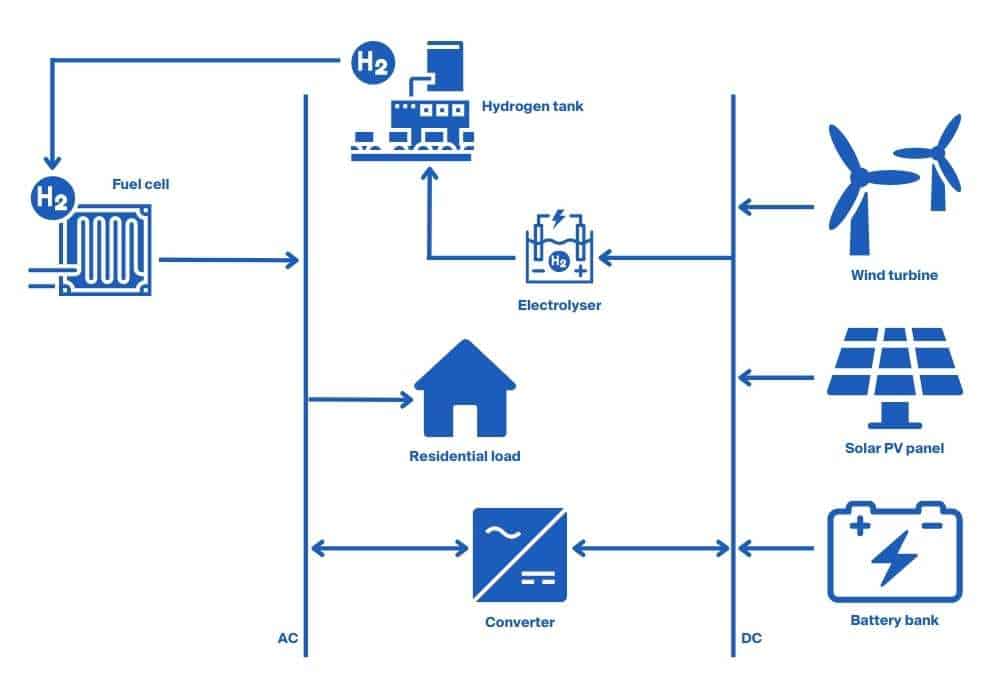Energy procurement is an ongoing issue for communities and projects operating off the national grid in remote areas.
Diesel-powered energy generation is expensive, it is also emissions-heavy, making it hard for companies to reach or maintain their carbon reduction goals.
Microgrids that use solar or wind and a battery storage system are increasingly popular in Australia, but as Horizon’s microgrid project in Denham, Western Australia shows, microgrid technologies are already moving towards hydrogen.
More resilient in terms of environmental factors than diesel generators (and more cost-efficient in the long-term), sustainable hydrogen microgrids could replace generators in remote farms, islands, and commercial and industrial sites — while helping companies and the country to decarbonise.
Microgrid basics
- Local energy systems that incorporate generation, storage and demand response and management systems in a single network
- Can be connected to a national or main grid or operate independently in ‘island mode’
- Can generate energy from a range of sources: natural gas, solar, wind
- Play a key role in decarbonisation efforts
- Highly configurable to end-users’ energy needs and goals.
Why hydrogen?
- Requires water which is an abundant feedstock for electrolysers
- Critical to achieving net zero
- Affordable to produce electricity once the infrastructure is in place
- Can be stored for a long time
- High energy content
- Can be used for electric generation and mobility
- Does not produce any greenhouse or carcinogenic gases
- Can be scaled up from a few kg/day to 1,000 kg/day
- Has been shown over many years to be used safely in oil refineries and fertilizer manufacture processes.
Microgrid options
The configurable nature of microgrids is one of the technology’s greatest selling points. It is also, from an investor’s point of view, one of the trickiest to navigate.
A lower-cost microgrid that utilises solar energy and a battery energy storage system (BESS), for example, can seem like the smart choice initially. However, battery efficiency losses and deterioration of battery capacity over time must also be considered.
On the other hand, an advanced microgrid that produces highly efficient green hydrogen from renewables and stores it in metal hydride requires more investment and a steady supply of desalinated water.
Another consideration across systems is the availability of maintenance and support, not all equipment vendors can provide maintenance, and this can be a determinant factor.
In remote areas, the market for renewable microgrids is expected to increase in the short to medium term. The hybridisation of existing diesel generators with local Renewable Energy Source (RES) based power systems is helping this growth.
Given their increasing performance and declining costs, batteries are currently the first choice of Electric Energy Storage (EES) system, making RES-based energy supply more reliable and effective.
However, batteries fall short when it comes to long-term storage and large loads, becoming expensive. Hydrogen represents an effective storage option in these cases, thanks to its long-term capability.
After comparing battery storage and hydrogen storage systems, an academic study found that battery storage has a higher net present value (NPV) compared to hydrogen storage. Regarding the component costs for hydrogen storage, the study showed that the cost of the electrolyser is the most significant factor affecting NPV. A hybrid storage system that combines both battery and hydrogen storage can benefit from the strengths of both individual systems.

Early research is key
Fyfe’s hydrogen engineers have conducted both internal rate of return (IRR) studies and feasibility studies on microgrids for clients. We have found that early studies allow clients to make better-informed investment decisions.
Investors need to be aware of numerous factors, including but not limited to:
- Net power requirements
- Sourcing equipment that’s compliant with Australian regulations
- Environmental constraints, such as cloud cover and footprint
- Federal and state planning requirements
- Available government funding
- Energy model constraints.
Our engineers have studied hydrogen’s value creation, from investing in hydrogen production from renewable energy resources in Australia to conducting comprehensive literature reviews for the projected future costs of green hydrogen.
Advanced energy modelling software using a dynamic software tool helps us to generate in-depth and reliable reports for our remote clients.
We believe that hydrogen microgrids could, at some point, replace diesel generators in remote areas and operation sites. Whether it’s the right choice for a specific location or specific use is a matter of balancing needs and constraints.
To learn more about our hydrogen service offerings, or to discuss whether a hydrogen microgrid is right for your site, please contact us.

